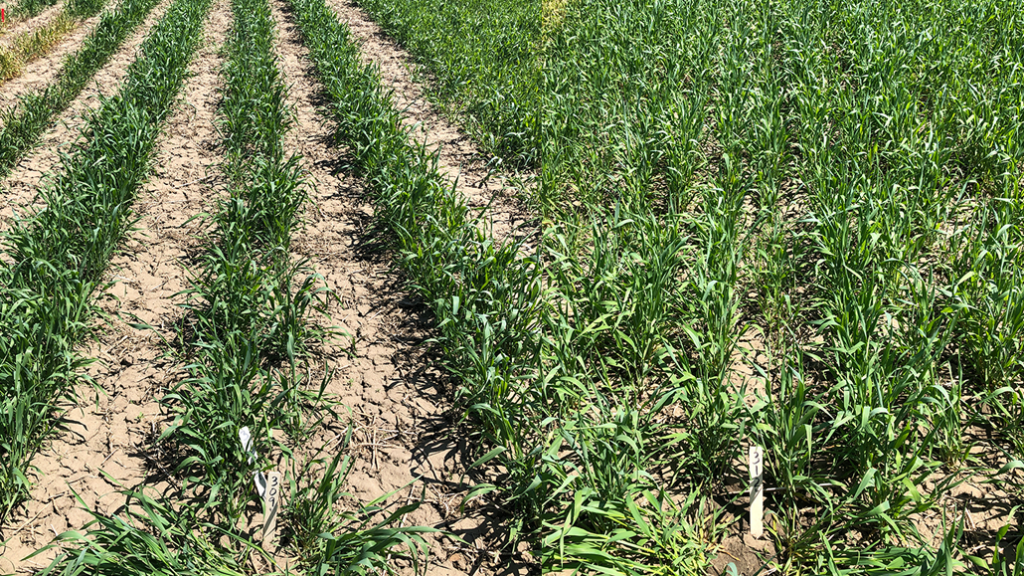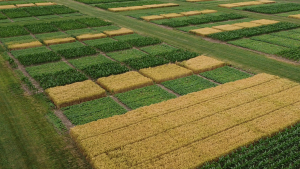Improved corn establishment
THE ROLE OF HERBICIDES AND COVER CROPS

COVER CROPS PLAY an important role in building soil quality and productivity on Ontario farms. Yet, even though their benefits are widely known, skepticism still exists. Farmers worry about the cost of implementation and that they might not get a return on investment. But in corn following fall rye, their biggest worries are reduced establishment and possible impact on yield.
A Grain Farmers of Ontario funded research project, led by University of Guelph crop science professor Dr. Francois Tardif, aims to investigate these concerns in order to provide concrete guidelines that will help more farmers adopt this important practice with confidence.
The benefits of cover crops are many. They help control weeds, capture carbon, reduce erosion, and build soil health. Building soil organic matter can help reduce nutrient loss and improve soil fertility, and healthier soil is better at filtering and holding water. Improved soil structure also helps to reduce compaction. While the benefits are many, farmers still have questions.
Tardif and his colleagues had three objectives in the first part of the study. First, they wanted to determine the best timing for cover crop termination prior to corn planting. Then, they wanted to ascertain whether or not the termination of cover crops with a herbicide providing fast burn would reduce the negative impacts seen when planting into standing cover. Finally, they wanted to find out if separating rye from corn when planted in twin rows would help improve corn establishment.
FIELD EXPERIMENTS
While the COVID-19 pandemic and associated measures created some challenges for the researchers, they were able to establish field experiments at Elora and Woodstock last year. Rye was seeded in October 2019 at Elora in two planting patterns: full planting with 7.5-inch row spacing, and partial planting at 7.5-inch row spacing with two rows planted and two rows skipped.
Measurements were taken in the following spring, and termination was initiated in May at two weeks, one week and one day before, as well as one week after corn was planted. Corn was planted on May 27. Termination was done using glyphosate or with a mix of glyphosate and glufosinate. Tardif and his colleagues collected data on the amount of rye cover, rye height, light quality, corn population and staging after emergence, as well as corn yield.
Preliminary results reveal that terminating the rye cover crop two weeks before planting resulted in corn yield that was as high as corn grown without a cover crop. But it may not be necessary to terminate so early, said Tardif. Terminating too early reduces the benefits of cover crops, particularly the accumulation of biomass, he said.
“Growers might be able to terminate just a few days before planting and still be okay,” he says.
Planting green, however, led to a 20 per cent yield loss, which Tardif attributes to an alteration of the quality of light reaching the emerging corn seedlings. Earlier research from University of Guelph weed scientist Clarence Swanton supports these findings. His research on early season seed competition found that corn plants perceive altered light from nearby plants and weeds as potential sources of competition. Corn responds to changes in light quality by issuing a series of shade-avoidance responses that forever change the structure of the plant.
The second part of the study was concerned with the establishment of inter-seeded cover crops into standing corn. Tardif wanted to see whether or not residual pre-corn herbicides limited establishment. This part of the study included evaluations of soil type and timing.
Tardif and his team inter-seeded six species of cover crops, including oats, winter rye, winter triticale, white clover, red clover, and oilseed radish, at the V6 stage of corn. The 12 most commonly used pre-emergent herbicides were assessed for inter-seeded cover crop tolerance. Corn was planted in May and inter-seeding of cover crops was done at the end of June. Assessments were taken during the summer of 2020 and the spring of 2021.
PRELIMINARY DATA
Although the results are preliminary at this point, Tardif said all cover crops established well under the corn canopy, although the clovers established more slowly than the other species. While the oats grew well, they were eventually decimated by leaf rust. All three cereals responded well to the pre-emergent herbicides and there was no visible injury on the resulting crop. Oilseed radish also established well and was not affected by the herbicides. There was injury on both clovers from Converge, Acuron, and Engarde. Primextra was only injurious to white clover, but not to red clover, said Tardif.
While the aim of the study is to be able to provide farmers with clear guidelines around termination and cover crop planting patterns, as well as possible risks of herbicide injury, with just one year of data to go on, it is still too early to offer anything concrete. Grad students are still analysing 2021 data.
“We haven’t got the yield yet, but what we observed in the second year looks promising,” says Tardif.
This project was funded in part by the Ontario Agri-Food Innovation Alliance, a collaboration between the government of Ontario and the University of Guelph. •

























